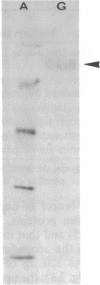Abstract
The slender bloodstream form of Trypanosoma brucei shows receptor-mediated endocytosis of low density lipoprotein (LDL) particles of its hosts. We have purified the LDL receptor of this species nearly to homogeneity (about 1000-fold purification) and obtained monospecific polyclonal antibodies against it. As analyzed by NaDodSO4/polyacrylamide gel electrophoresis, the purified receptor consists of a single subunit, with an apparent molecular mass of 86 kDa. Its isoelectric point is 5.9. On the average, each cell exposes 52,000 copies of low-affinity receptors (Kd of 250 nM) and 1800 copies of high-affinity receptors (Kd of 5.7 nM). According to indirect en bloc immunolabeling of fixed parasites, the receptor appears to be localized to the flagellar pocket membrane and the flagellar membrane and to be completely absent from the rest of the pericellular membrane. LDL is required for optimal growth of the trypanosome in vitro: cell growth can be inhibited either by removal of LDL from the culture medium or by antibodies against the purified LDL receptors. In both cases, growth is restored by the addition of excess LDL.
Full text
PDF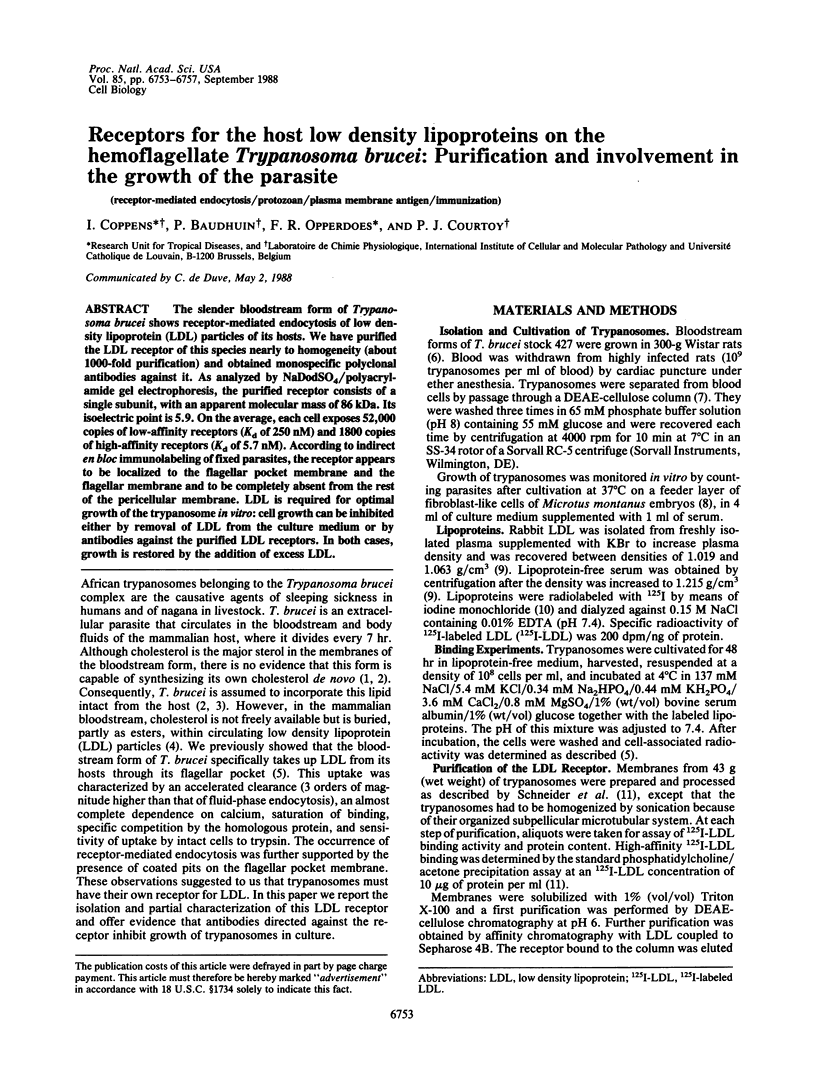
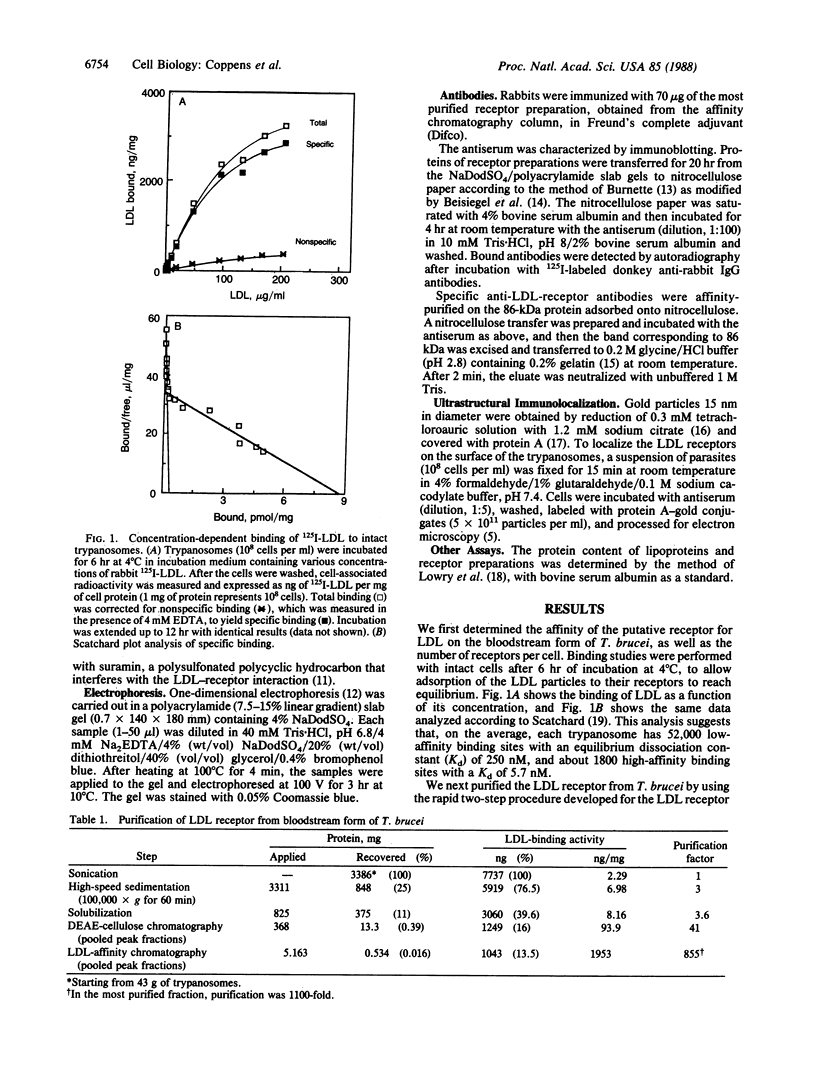
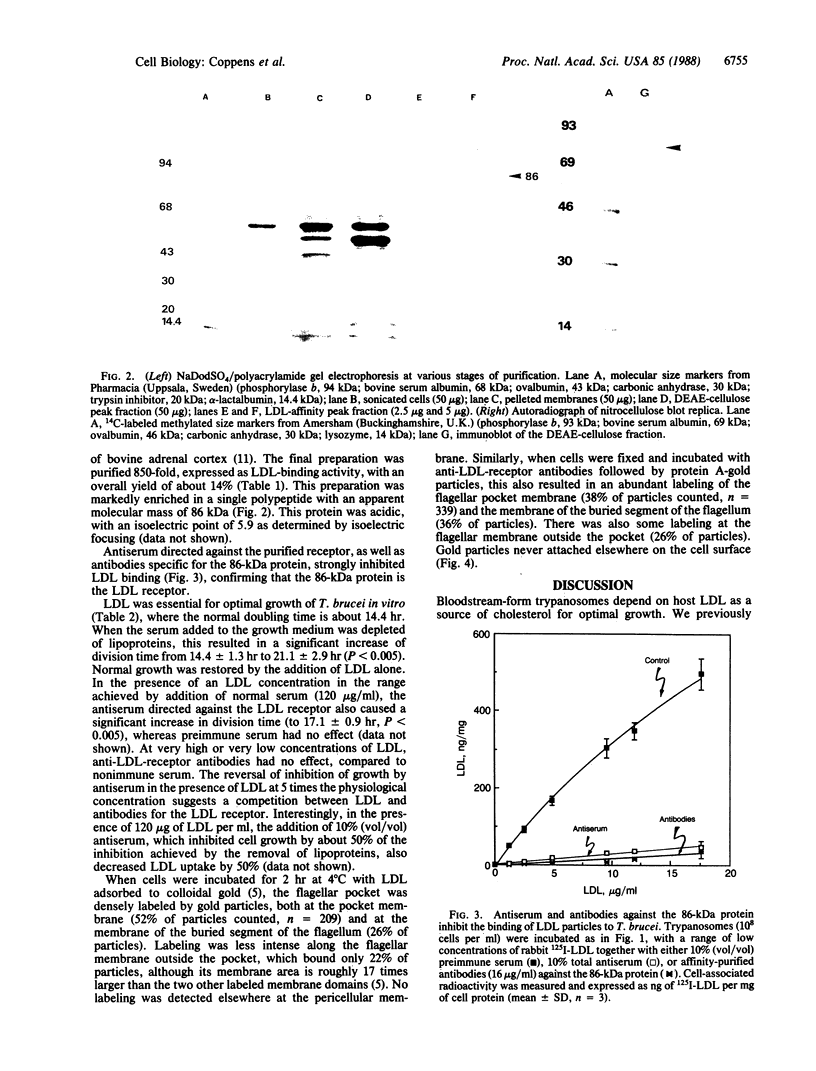
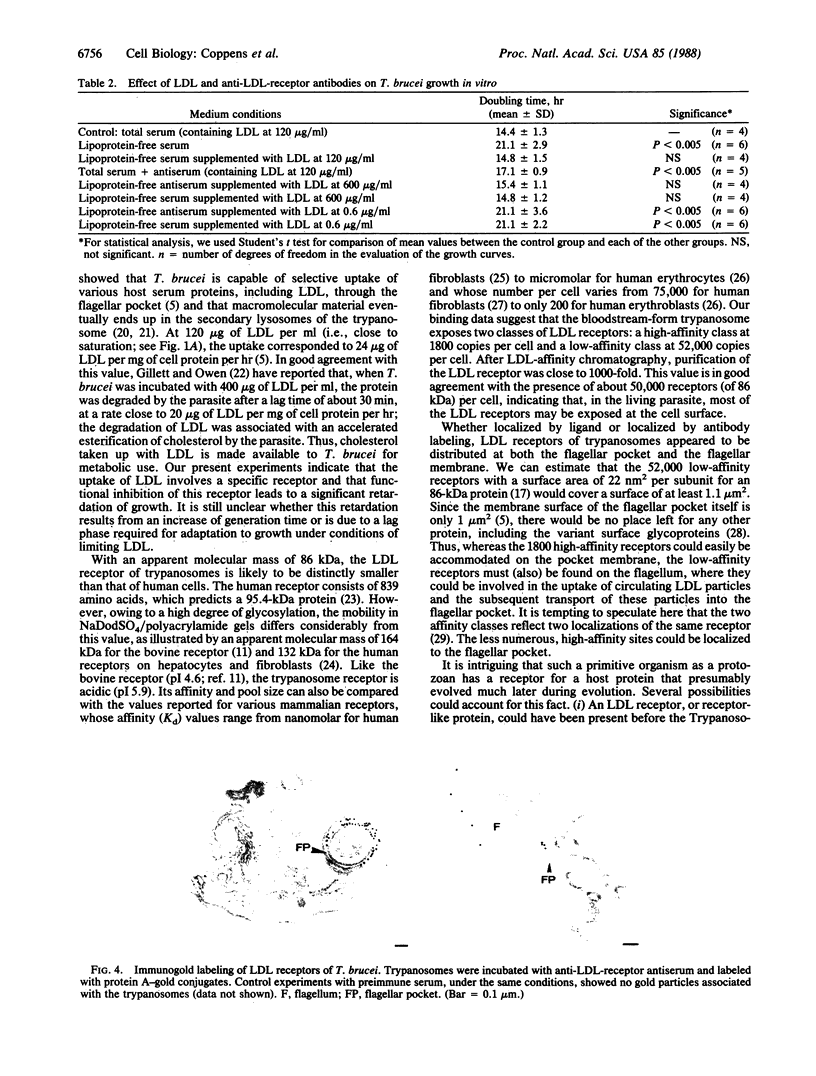
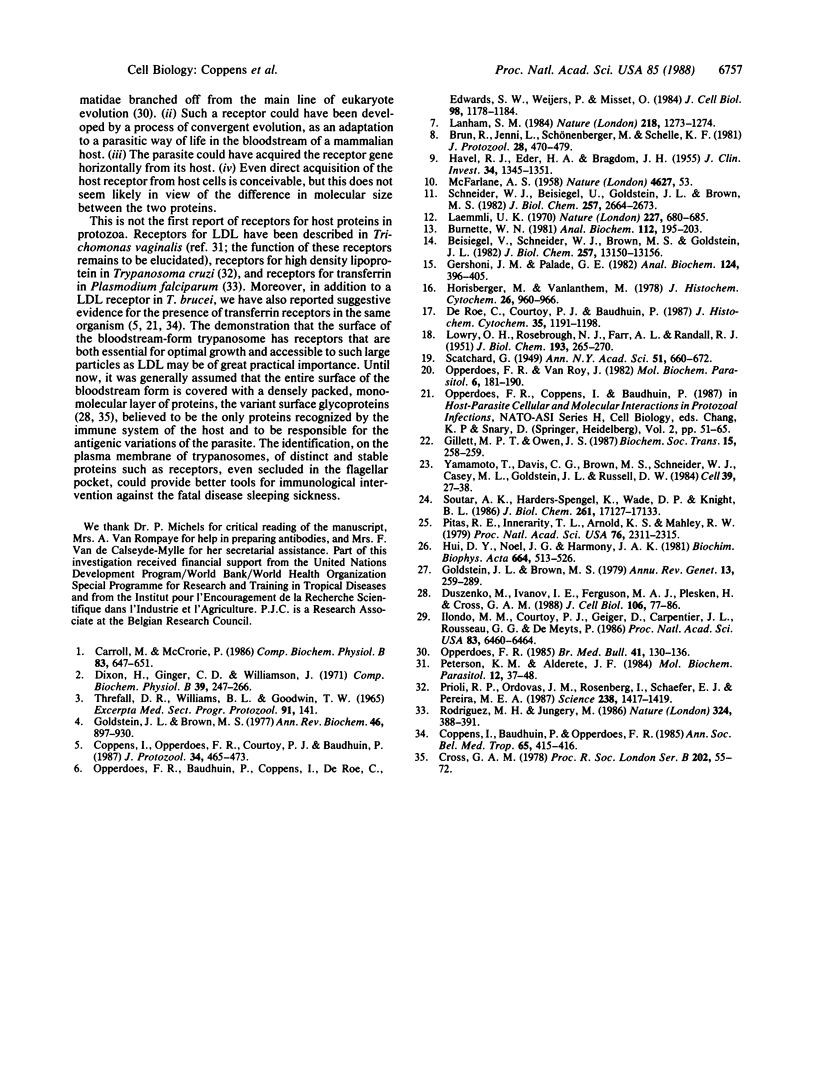
Images in this article
Selected References
These references are in PubMed. This may not be the complete list of references from this article.
- Beisiegel U., Schneider W. J., Brown M. S., Goldstein J. L. Immunoblot analysis of low density lipoprotein receptors in fibroblasts from subjects with familial hypercholesterolemia. J Biol Chem. 1982 Nov 10;257(21):13150–13156. [PubMed] [Google Scholar]
- Brun R., Jenni L., Schönenberger M., Schell K. F. In vitro cultivation of bloodstream forms of Trypanosoma brucei, T. rhodesiense, and T. gambiense. J Protozool. 1981 Nov;28(4):470–479. doi: 10.1111/j.1550-7408.1981.tb05322.x. [DOI] [PubMed] [Google Scholar]
- Burnette W. N. "Western blotting": electrophoretic transfer of proteins from sodium dodecyl sulfate--polyacrylamide gels to unmodified nitrocellulose and radiographic detection with antibody and radioiodinated protein A. Anal Biochem. 1981 Apr;112(2):195–203. doi: 10.1016/0003-2697(81)90281-5. [DOI] [PubMed] [Google Scholar]
- Carroll M., McCrorie P. Lipid composition of bloodstream forms of Trypanosoma brucei brucei. Comp Biochem Physiol B. 1986;83(3):647–651. doi: 10.1016/0305-0491(86)90312-3. [DOI] [PubMed] [Google Scholar]
- Coppens I., Opperdoes F. R., Courtoy P. J., Baudhuin P. Receptor-mediated endocytosis in the bloodstream form of Trypanosoma brucei. J Protozool. 1987 Nov;34(4):465–473. doi: 10.1111/j.1550-7408.1987.tb03216.x. [DOI] [PubMed] [Google Scholar]
- De Roe C., Courtoy P. J., Baudhuin P. A model of protein-colloidal gold interactions. J Histochem Cytochem. 1987 Nov;35(11):1191–1198. doi: 10.1177/35.11.3655323. [DOI] [PubMed] [Google Scholar]
- Dixon H., Ginger C. D., Williamson J. The lipid metabolism of blood and culture forms of Trypanosoma lewisi and Trypanosoma rhodesiense. Comp Biochem Physiol B. 1971 Jun 15;39(2):247–266. doi: 10.1016/0305-0491(71)90168-4. [DOI] [PubMed] [Google Scholar]
- Duszenko M., Ivanov I. E., Ferguson M. A., Plesken H., Cross G. A. Intracellular transport of a variant surface glycoprotein in Trypanosoma brucei. J Cell Biol. 1988 Jan;106(1):77–86. doi: 10.1083/jcb.106.1.77. [DOI] [PMC free article] [PubMed] [Google Scholar]
- Gershoni J. M., Palade G. E. Electrophoretic transfer of proteins from sodium dodecyl sulfate-polyacrylamide gels to a positively charged membrane filter. Anal Biochem. 1982 Aug;124(2):396–405. doi: 10.1016/0003-2697(82)90056-2. [DOI] [PubMed] [Google Scholar]
- Goldstein J. L., Brown M. S. The LDL receptor locus and the genetics of familial hypercholesterolemia. Annu Rev Genet. 1979;13:259–289. doi: 10.1146/annurev.ge.13.120179.001355. [DOI] [PubMed] [Google Scholar]
- Goldstein J. L., Brown M. S. The low-density lipoprotein pathway and its relation to atherosclerosis. Annu Rev Biochem. 1977;46:897–930. doi: 10.1146/annurev.bi.46.070177.004341. [DOI] [PubMed] [Google Scholar]
- HAVEL R. J., EDER H. A., BRAGDON J. H. The distribution and chemical composition of ultracentrifugally separated lipoproteins in human serum. J Clin Invest. 1955 Sep;34(9):1345–1353. doi: 10.1172/JCI103182. [DOI] [PMC free article] [PubMed] [Google Scholar]
- Horisberger M., VonLanthen M. Simultaneous localization of an hepatic binding protein specific for galactose and of galactose-containing receptors on rat hepatocytes. J Histochem Cytochem. 1978 Nov;26(11):960–966. doi: 10.1177/26.11.722052. [DOI] [PubMed] [Google Scholar]
- Hui D. Y., Noel J. G., Harmony J. A. Binding of plasma low density lipoproteins to erythrocytes. Biochim Biophys Acta. 1981 Jun 23;664(3):513–526. doi: 10.1016/0005-2760(81)90129-6. [DOI] [PubMed] [Google Scholar]
- Ilondo M. M., Courtoy P. J., Geiger D., Carpentier J. L., Rousseau G. G., De Meyts P. Intracellular potassium depletion in IM-9 lymphocytes suppresses the slowly dissociating component of human growth hormone binding and the down-regulation of its receptors but does not affect insulin receptors. Proc Natl Acad Sci U S A. 1986 Sep;83(17):6460–6464. doi: 10.1073/pnas.83.17.6460. [DOI] [PMC free article] [PubMed] [Google Scholar]
- LOWRY O. H., ROSEBROUGH N. J., FARR A. L., RANDALL R. J. Protein measurement with the Folin phenol reagent. J Biol Chem. 1951 Nov;193(1):265–275. [PubMed] [Google Scholar]
- Laemmli U. K. Cleavage of structural proteins during the assembly of the head of bacteriophage T4. Nature. 1970 Aug 15;227(5259):680–685. doi: 10.1038/227680a0. [DOI] [PubMed] [Google Scholar]
- Lanham S. M. Separation of trypanosomes from the blood of infected rats and mice by anion-exchangers. Nature. 1968 Jun 29;218(5148):1273–1274. doi: 10.1038/2181273a0. [DOI] [PubMed] [Google Scholar]
- McFARLANE A. S. Efficient trace-labelling of proteins with iodine. Nature. 1958 Jul 5;182(4627):53–53. doi: 10.1038/182053a0. [DOI] [PubMed] [Google Scholar]
- Opperdoes F. R., Baudhuin P., Coppens I., De Roe C., Edwards S. W., Weijers P. J., Misset O. Purification, morphometric analysis, and characterization of the glycosomes (microbodies) of the protozoan hemoflagellate Trypanosoma brucei. J Cell Biol. 1984 Apr;98(4):1178–1184. doi: 10.1083/jcb.98.4.1178. [DOI] [PMC free article] [PubMed] [Google Scholar]
- Opperdoes F. R. Biochemical peculiarities of trypanosomes, African and South American. Br Med Bull. 1985 Apr;41(2):130–136. doi: 10.1093/oxfordjournals.bmb.a072039. [DOI] [PubMed] [Google Scholar]
- Opperdoes F. R., Van Roy J. Involvement of lysosomes in the uptake of macromolecular material by bloodstream forms of Trypanosoma brucei. Mol Biochem Parasitol. 1982 Sep;6(3):181–190. doi: 10.1016/0166-6851(82)90077-9. [DOI] [PubMed] [Google Scholar]
- Peterson K. M., Alderete J. F. Selective acquisition of plasma proteins by Trichomonas vaginalis and human lipoproteins as a growth requirement for this species. Mol Biochem Parasitol. 1984 May;12(1):37–48. doi: 10.1016/0166-6851(84)90042-2. [DOI] [PubMed] [Google Scholar]
- Pitas R. E., Innerarity T. L., Arnold K. S., Mahley R. W. Rate and equilibrium constants for binding of apo-E HDLc (a cholesterol-induced lipoprotein) and low density lipoproteins to human fibroblasts: evidence for multiple receptor binding of apo-E HDLc. Proc Natl Acad Sci U S A. 1979 May;76(5):2311–2315. doi: 10.1073/pnas.76.5.2311. [DOI] [PMC free article] [PubMed] [Google Scholar]
- Prioli R. P., Ordovas J. M., Rosenberg I., Schaefer E. J., Pereira M. E. Similarity of cruzin, an inhibitor of Trypanosoma cruzi neuraminidase, to high-density lipoprotein. Science. 1987 Dec 4;238(4832):1417–1419. doi: 10.1126/science.3120314. [DOI] [PubMed] [Google Scholar]
- Rodriguez M. H., Jungery M. A protein on Plasmodium falciparum-infected erythrocytes functions as a transferrin receptor. 1986 Nov 27-Dec 3Nature. 324(6095):388–391. doi: 10.1038/324388a0. [DOI] [PubMed] [Google Scholar]
- Schneider W. J., Beisiegel U., Goldstein J. L., Brown M. S. Purification of the low density lipoprotein receptor, an acidic glycoprotein of 164,000 molecular weight. J Biol Chem. 1982 Mar 10;257(5):2664–2673. [PubMed] [Google Scholar]
- Soutar A. K., Harders-Spengel K., Wade D. P., Knight B. L. Detection and quantitation of low density lipoprotein (LDL) receptors in human liver by ligand blotting, immunoblotting, and radioimmunoassay. LDL receptor protein content is correlated with plasma LDL cholesterol concentration. J Biol Chem. 1986 Dec 25;261(36):17127–17133. [PubMed] [Google Scholar]
- Yamamoto T., Davis C. G., Brown M. S., Schneider W. J., Casey M. L., Goldstein J. L., Russell D. W. The human LDL receptor: a cysteine-rich protein with multiple Alu sequences in its mRNA. Cell. 1984 Nov;39(1):27–38. doi: 10.1016/0092-8674(84)90188-0. [DOI] [PubMed] [Google Scholar]



